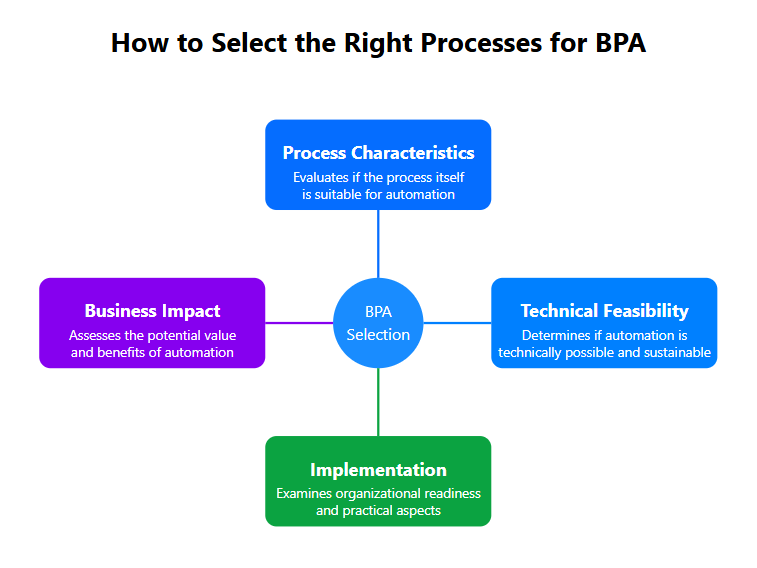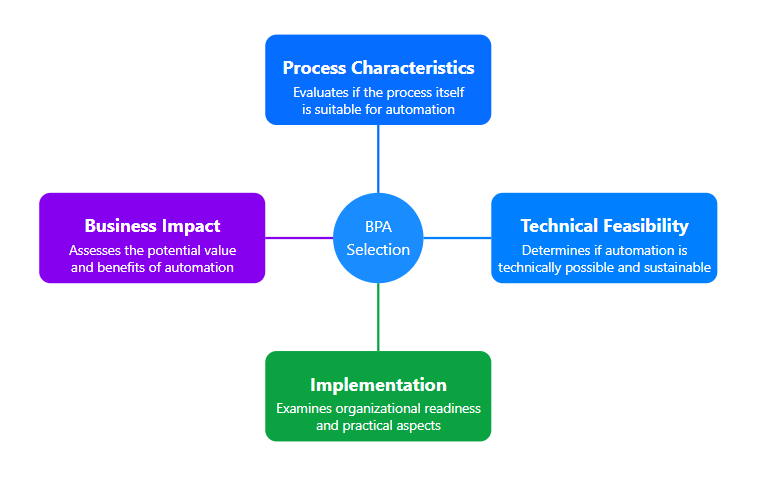It is abundantly clear that automation is the key to keeping up with changing economic conditions and fierce competition. Today, process automation goes far beyond simple, repetitive tasks—it has evolved into a sophisticated solution capable of addressing even the most complex workflows and challenges.
You might already have a business process automation (BPA) vendor in place or be exploring different options to help you automate business processes. Alternatively, you may be looking to maximize the value of your automation software by applying it within your department.
No matter where you stand in your automation journey, one critical question remains: which processes should you automate? And among those, where should you begin? Which processes make the most sense to automate and what are the questions that guide you in this analysis?
Topics to Guide You in Choosing the Right Processes to Automate
Identifying the right workflows for process automation is essential for achieving meaningful results with BPA. Without careful selection, larger companies risk investing millions without seeing a positive ROI on their automation initiatives.

When prioritizing processes for automation, consider the following key areas:
- Process characteristics: Evaluate the fundamental nature of the process to determine its suitability for automation.
- Business value: Assess the potential impact and benefits that automation could bring to the organization.
- Technical feasibility: Analyze the technical requirements and ensure the process can be effectively automated with the available software.
- Implementation factors and risks: Take into account practical considerations for implementation, such as resources, timelines, and training.
By focusing on these areas, you can ensure your automation efforts deliver maximum value and measurable success.
Process Characteristics
The first and most important criterion to consider when selecting processes for automation is their characteristics. Although automation software is available, it doesn’t mean everything must be automated. Some processes are better suited to automation than others.
BPA software is advancing rapidly each year, with many challenges once considered obstacles now being addressed by these tools. Technologies like generative AI are driving this remarkable progress. Still, it’s wise to start with simpler, high-impact processes to achieve the best return on investment before tackling more complex workflows.
But what specific features make a process more suitable for automation?
- High volume
Processes that occur frequently or handle large volumes of data or transactions are prime candidates for automation. Examples include invoice processing, data entry, employee onboarding, and purchase order creation. Even a slight time saving per instance can result in significant benefits when scaled across numerous repetitions.
- Manual and repetitive actions
Perhaps the most critical factor is whether the task is currently completed manually and repetitively. If so, it’s likely a strong contender for automation. Tasks like copy-pasting data between systems or generating routine reports fall into this category and can be found in virtually every department. Look for processes that don’t require creativity or complex problem-solving where humans are essentially acting as “human computers.”
- Standardization
Highly standardized processes with minimal variations or exceptions make the best candidates for automation. Ideally, processes should have an exception rate below 15-20%. Higher variability can increase the complexity or cost of automation.
That said, even processes with exceptions can be automated if the exceptions are predictable and manageable. Modern process automation tools like ProcessMaker offer impressive exception-handling capabilities, enabling the automation of workflows that are less standardized.
- Rule-based steps
Processes governed by clear rules and consistent logic are far easier to automate than those requiring sophisticated judgment or nuanced decision-making. Examples include initial insurance claim screenings or preliminary checks for loan applications.
- Digital input
Processes reliant on unstructured data or unconventional input formats are more challenging to automate and may require extra effort.
However, advances in tools like text-to-process and text-to-image technologies have made even these processes more accessible for automation. For instance, taking a photo of a hand-drawn workflow or a handwritten process from a CEO can now be transformed into automated workflows with tools like ProcessMaker.
By considering these process characteristics, you can pinpoint which processes are most suitable for automation and prioritize those that will deliver the greatest impact.
Business Impact
- Measurable impact
For an automation initiative to truly make a difference, the process must have defined start and end points, along with measurable outcomes. It should deliver quantifiable benefits such as time savings, error reduction, and cost efficiency, supported by clear KPIs. Comparing performance before and after automation is vital to determining if the effort was worthwhile.
- Time savings
One of the key advantages of automation is its ability to save significant manual hours. Automation can complete tasks faster than humans, with fewer errors, particularly for repetitive jobs. This efficiency frees up time for more strategic, value-added activities. Therefore, consider automating the workflows that lead to substantial time savings before you automate anything else.
- Error reduction
Repetitive and tedious tasks can often lead to boredom and mistakes when performed by humans. Automation mitigates this risk by executing tasks with consistent accuracy, reducing human error and improving overall reliability.
- Cost efficiency
The costs associated with the automation of a certain process must be justified by its long-term savings. A clear return on investment (ROI) is essential to ensure the initiative delivers value. Automating processes should lead to lower operational costs over time while enhancing productivity.
- Customer impact
Finally, automation efforts must positively impact customer satisfaction. After all, improving the customer experience is the ultimate objective. Whether through faster service, fewer errors, or better support, customer benefits should be central to any automation strategy. Therefore, whether a certain process is a priority to automate or not should be based on its impact on customers.
Technical feasibility
The topic of technical feasibility can differ greatly from one organization to another, as well as between vendors offering automation solutions. Here are some key technical factors to consider when selecting processes for automation:
- System integration
Evaluate whether the software apps involved in the process offer suitable APIs or integration points. Custom integrations, particularly with legacy systems, can become complex and costly, so this is an important consideration.
- Data quality
Automation works most effectively when input data is consistent and of high quality. Ensuring data readiness can significantly ease the implementation process.
- Security and compliance
It’s essential to confirm that automation initiatives meet security and compliance requirements. Regulated industries, in particular, often have stricter standards, so paying attention to these details is critical.
- Support resources
Depending on the complexity of the process, the automation vendor, and the resources available within your organization, you may need technical expertise to implement and maintain the project. Some tools cater more to developers and technical teams, while others, like ProcessMaker, offer low-code, drag-and-drop environments that are easier to use.
That said, modern BPA platforms are evolving to address these limitations, making many of these considerations less daunting. For instance, ProcessMaker simplifies custom integrations and also includes pre-built connectors for popular applications, reducing setup effort and complexity.
Implementation factors and risks
- Stakeholder support
For any automation initiative to succeed, it is essential for all relevant stakeholders to be aligned and supportive. The teams and units involved in the process under consideration must be prepared for the change. Resistance or lack of alignment can make it difficult to implement automation effectively.
- Resource availability
Sufficient resources, including the necessary budget and personnel, must be available to support the automation of the selected process.
- Timeline alignment
The implementation timeline of an automated process should align with the business’s current priorities. It is not practical to focus on automating a low-priority process when other processes directly influence the organization’s most urgent goals.
- Risk level
The risks associated with automation should be manageable and accompanied by clear mitigation strategies to ensure the initiative’s success.
Automate the prioritization of processes
These are some of the key characteristics to consider when deciding which processes to automate. As you can see, the prioritization process alone can require significant time and effort.
If you want to avoid spending endless hours conducting interviews, organizing workshops, and making observations to understand the true state of your business processes—such as identifying which are more manual, high-volume, or standardized—technology can take over this burden for you.
With advanced process intelligence technology, you gain complete transparency into your business processes. This method identifies automation opportunities in a prioritized and data-driven way, eliminating the need to manually assess every process or make tough calls about which ones to tackle first.
The software takes care of it automatically and accurately, drawing conclusions based on real data rather than relying on instinct or guesswork.





